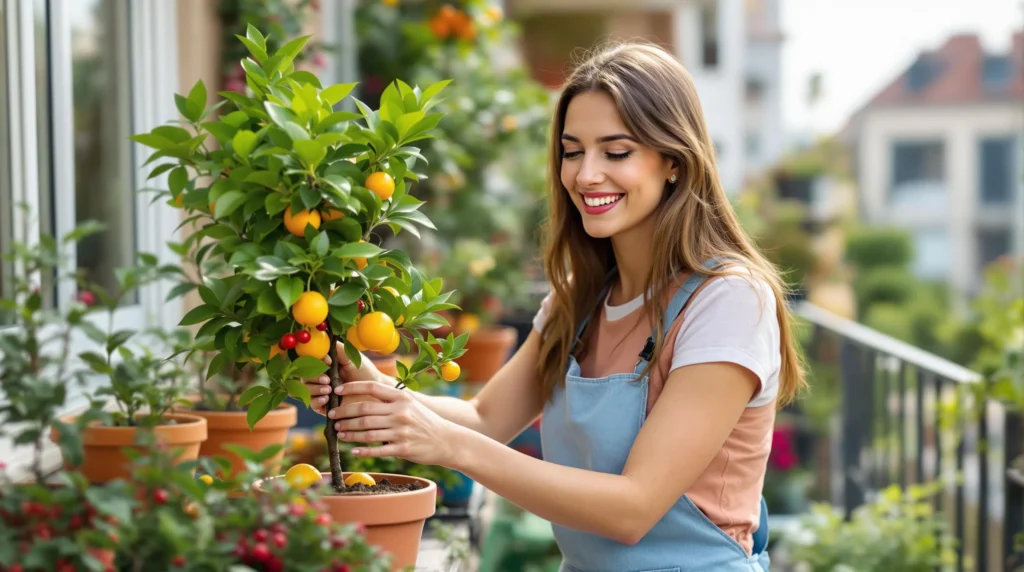Top 10 Potted Fruit Tree Ideas for Small Spaces
1. Dwarf Citrus Trees
Dwarf citrus trees thrive in containers and produce full-sized fruits even though their compact nature. Meyer lemons, Key limes, and kumquats are excellent choices as they adapt well to pot life. These trees need at least 6 hours of direct sunlight daily and well-draining soil. A 15-20 gallon container with drainage holes will give your citrus tree ample room to grow while keeping it manageable for small spaces like balconies or patios.
2. Columnar Apple Trees
Columnar apple trees grow straight up with minimal branching, making them perfect for tight spaces. Varieties like ‘Northpole’ and ‘Golden Sentinel’ can produce up to 20 pounds of fruit per season while maintaining a slender profile of just 2 feet wide. These space-efficient trees need a 10-15 gallon pot and can even be arranged in a row to create a beautiful, productive privacy screen on a deck or patio.
3. Fig Trees
Fig trees adapt surprisingly well to container life and can produce two harvests annually. Compact varieties like ‘Petite Negra’ and ‘Little Miss Figgy’ are especially suitable for pots. These heat-loving trees require minimal pruning and can be overwintered indoors in colder climates. A 15-20 gallon container allows enough room for roots while keeping the tree at a manageable 4-6 feet tall in containers.
4. Dwarf Cherry Trees
Dwarf cherry trees offer beautiful spring blossoms followed by delicious summer fruits. Self-pollinating varieties like ‘North Star’ (sour) and ‘Stella’ (sweet) are ideal for container growing since you’ll only need one tree to produce fruit. These trees require a pot at least 18 inches deep and wide, with excellent drainage to prevent root rot. In containers, they’ll typically stay under 8 feet tall while producing full-sized cherries.
5. Miniature Peach Trees
Genetic dwarf peach varieties like ‘Bonanza’ and ‘Garden Gold’ grow just 4-6 feet tall even when mature, making them perfect for containers. These compact trees produce full-sized, sweet peaches and feature stunning pink spring blossoms. They need a 20-gallon container minimum and prefer a location with protection from strong winds. Their naturally small stature eliminates the need for complex pruning techniques.
6. Blueberry Bushes
While not technically trees, dwarf blueberry bushes are perfect for container growing, with varieties like ‘Top Hat’ and ‘Northsky’ staying under 2 feet tall. They require acidic soil (pH 4.5-5.5) and look attractive year-round with spring flowers, summer berries, and vibrant fall foliage. For best results, plant them in 12-16 inch containers with ericaceous compost and provide consistent moisture. Most compact varieties produce full-sized, sweet berries.
7. Dwarf Pomegranate
Dwarf pomegranate trees like ‘Nana’ grow just 2-3 feet tall in containers while producing ornamental orange-red flowers and smaller, but equally flavorful fruits. These drought-tolerant trees are perfect for hot, sunny patios and require minimal care once established. A 12-15 gallon pot provides adequate space, and they can be successfully grown in zones 7-10 outdoors year-round or brought inside during winter in colder regions.
8. Potted Mulberry
Dwarf mulberry varieties like ‘Issai’ and ‘Dwarf Everbearing’ are well-suited for container life, producing sweet berries throughout summer. These fast-growing trees need a 20-gallon container minimum and benefit from regular pruning to maintain their compact shape. Mulberries are exceptionally hardy and disease-resistant, making them perfect for beginning fruit gardeners. Position them where fallen berries won’t stain patios or walkways.
9. Container Pear Trees
Dwarf pear varieties like ‘Bartlett’ and ‘D’Anjou’ grafted onto quince rootstock remain compact in containers while producing full-sized, delicious fruits. These trees require a 20-gallon pot minimum and benefit from staking to support heavy fruit loads. Pears need good air circulation to prevent disease, so they’re ideal for open balconies or rooftop gardens. Most dwarf varieties stay under 8 feet tall in containers.
10. Potted Avocado Trees
Dwarf avocado varieties like ‘Wurtz’ (Little Cado) and ‘Gwen’ can thrive in large containers and produce full-sized fruits. These trees need at least a 24-inch diameter pot and well-draining soil. While they require more space than other potted fruit trees, their compact nature (growing 8-10 feet in containers versus 20-30 feet in the ground) makes them manageable for larger patios or terraces. They’re perfect for zones 9-11 or can be moved indoors during winter in colder regions.
Choosing the Right Container for Your Potted Fruit Trees
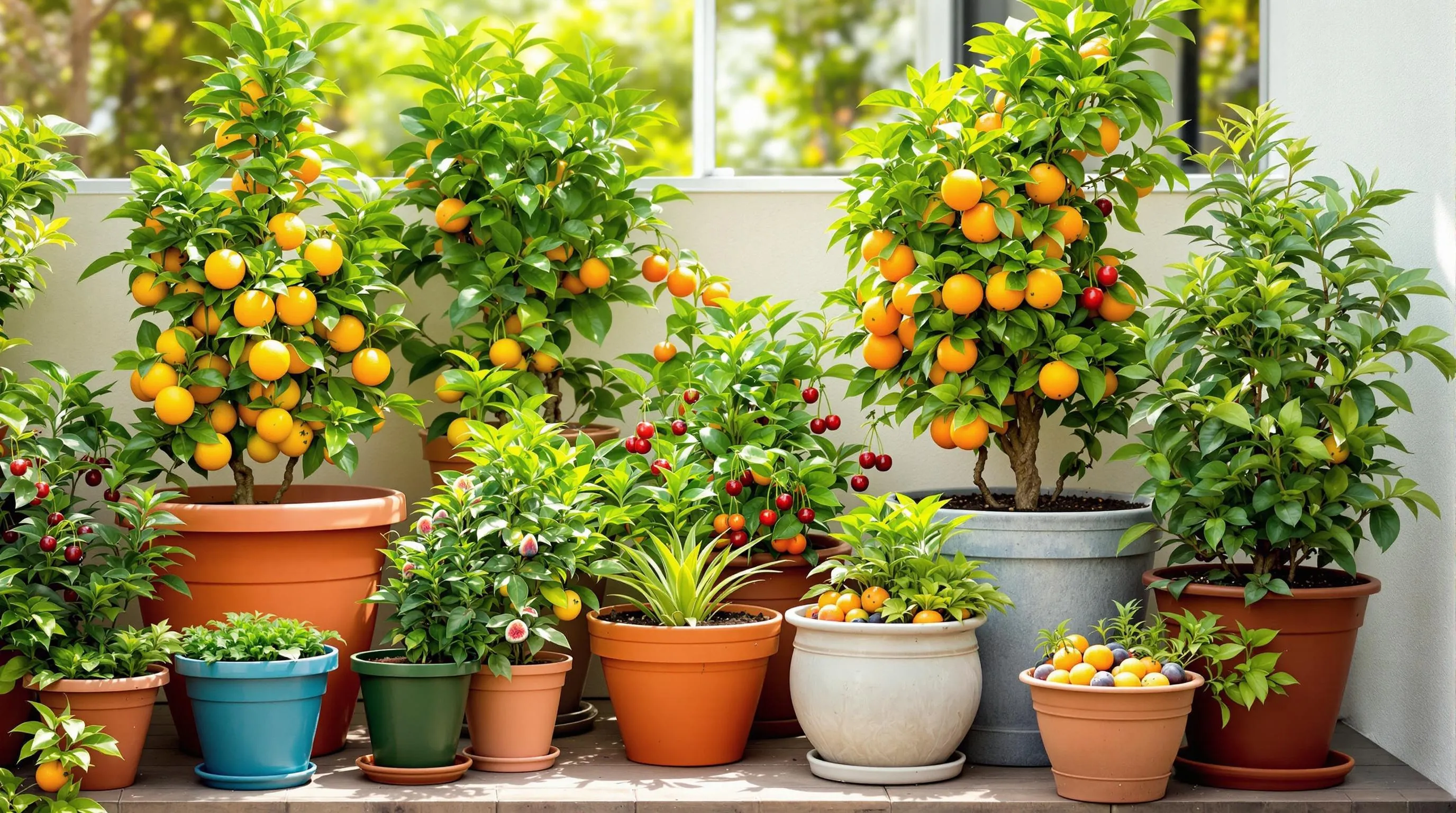
The success of your potted fruit trees depends greatly on selecting appropriate containers. Your choice will impact root development, nutrient availability, and the overall health of your trees.
Size and Material Considerations
Container size directly affects your fruit tree’s growth potential. Choose pots that provide at least 12-16 inches of depth for proper root development, with dwarf varieties needing 10-15 gallon containers and semi-dwarf trees requiring 20+ gallons. Material matters too—terracotta pots offer excellent breathability but dry out quickly, while plastic containers retain moisture longer but provide less insulation. Ceramic pots combine aesthetics with functionality but tend to be heavier and more expensive. Fabric grow bags present an innovative option with superior aeration and root pruning capabilities. For long-term growth, select containers that are slightly larger than your tree’s current root ball, allowing 2-3 inches of space around the sides for growth.
Drainage Requirements for Healthy Fruit Trees
Proper drainage is non-negotiable for potted fruit trees. Ensure your containers have multiple drainage holes (at least 3-4) at the bottom to prevent water pooling that can lead to root rot. Elevate pots slightly using pot feet or small stones to improve airflow and water escape. Add a 1-2 inch layer of coarse materials like gravel or broken pottery pieces at the container bottom before adding soil. For heavy clay-based potting mixes, incorporate perlite or pumice (about 20% of total volume) to enhance drainage. During hot summer months, check moisture levels frequently as container-grown trees dry out faster than ground-planted ones. Remember that different fruit varieties have varying moisture needs—citrus trees generally require more consistent moisture than fig trees, which prefer to dry out between waterings.
Best Dwarf Citrus Trees for Container Gardening
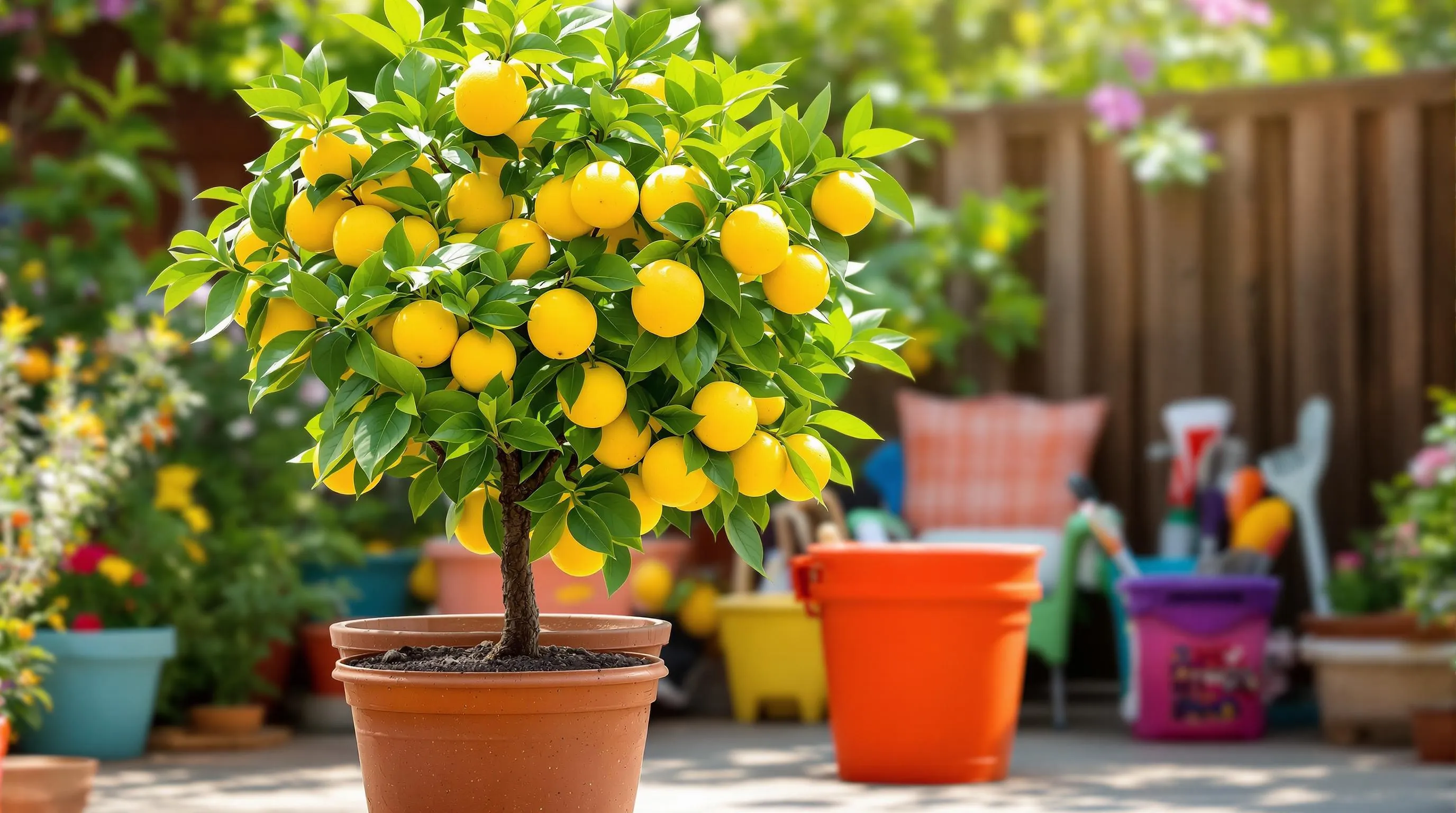
Dwarf citrus trees are ideal candidates for container gardening, offering year-round beauty and fragrant fruits in compact spaces. These varieties have been specially bred to thrive in pots while still producing full-sized, delicious fruits.
Meyer Lemons: The Perfect Potted Citrus
Meyer lemons stand out as the quintessential potted citrus tree for beginners and experienced gardeners alike. These compact trees typically grow just 4-6 feet tall in containers, making them perfect for patios, balconies, or sunny indoor spots. Meyer lemons produce sweeter, less acidic fruits than standard lemons, with thin, fragrant skin and juicy flesh that’s excellent for cooking and beverages. They’re remarkably prolific, often blooming and fruiting multiple times per year when given proper care. For best results, place your Meyer lemon in a 15-20 gallon container with well-draining citrus soil, and position it where it’ll receive 6-8 hours of direct sunlight daily.
Kumquats and Mandarins for Compact Spaces
Kumquats and mandarin varieties like Satsumas and Clementines excel in container environments due to their naturally compact growth habits. Kumquat trees rarely exceed 4 feet in containers and produce small, oval-shaped fruits that can be eaten whole—skin and all—offering a unique sweet-tart flavor experience. Mandarin varieties typically stay under 6 feet in pots and yield easy-peel, seedless fruits that are sweeter than most other citrus options. Both varieties are cold-hardier than many citrus trees, tolerating brief temperature dips to 25-28°F, though they should still be protected or moved indoors during freezing weather. These trees thrive in 15-inch or larger containers with excellent drainage and consistent moisture, rewarding you with ornamental beauty and harvests of vitamin-rich fruits.
Stone Fruit Options That Thrive in Pots
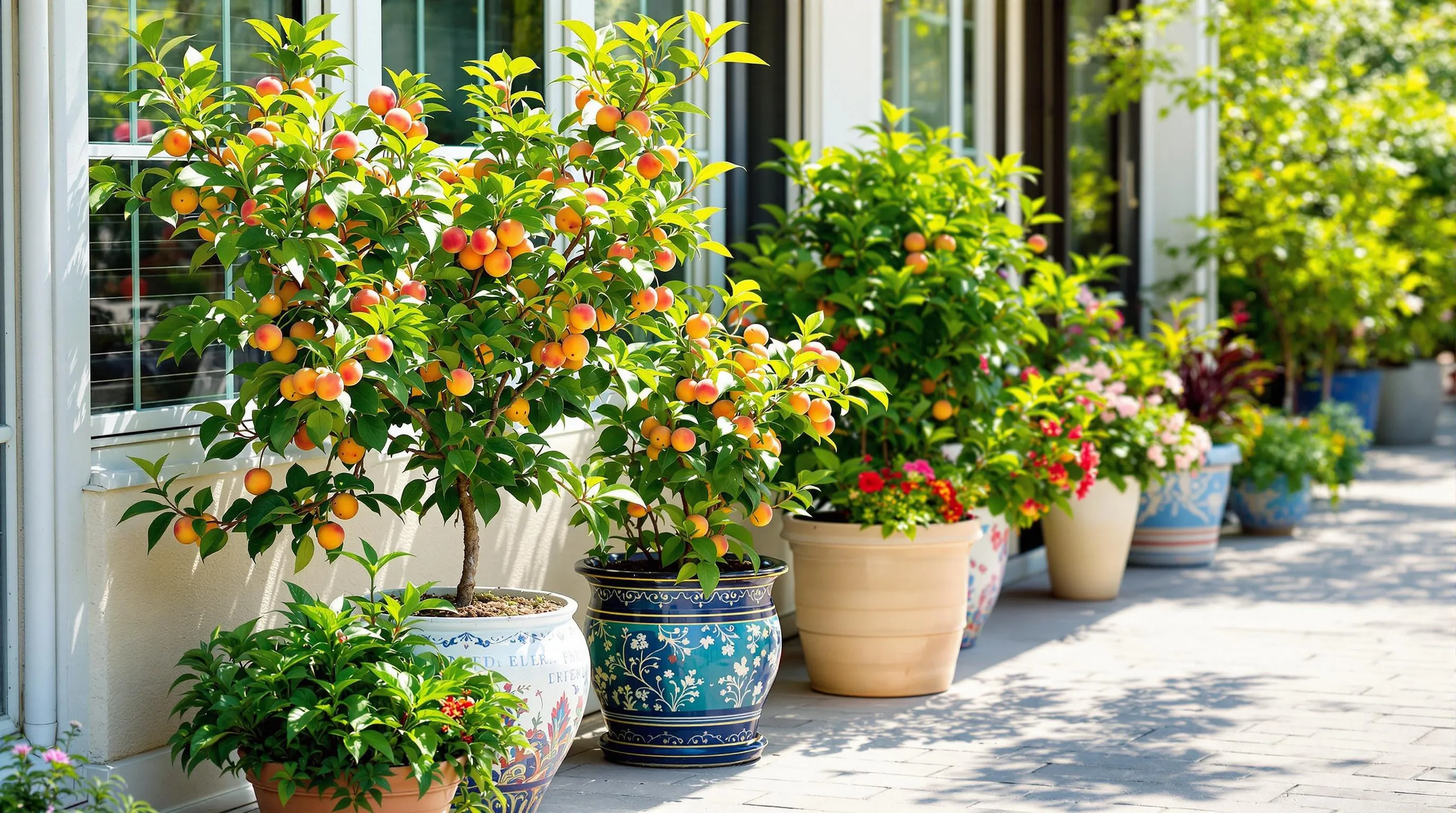
Stone fruits make excellent candidates for container gardening, offering beautiful blossoms and delicious harvests even in limited spaces. These compact varieties bring the orchard experience to your patio or balcony with proper care.
Container-Friendly Cherry Varieties
Dwarf cherry trees are perfect for pot cultivation, typically reaching only 6-8 feet tall when mature. ‘Romeo’ and ‘Juliet’ cherry varieties excel in containers, requiring minimal space while producing full-sized, sweet cherries. Self-pollinating options like ‘Stella’ and ‘Black Gold’ eliminate the need for multiple trees, making them ideal for small-space gardening. For best results, choose a pot at least 18-24 inches wide and deep, using well-draining potting mix amended with compost. Cherry trees thrive in full sun locations and require regular watering, especially during fruit development. Protect your potted cherries from birds with netting once fruits begin to ripen to ensure you’ll enjoy the harvest.
Dwarf Peach and Plum Selections
Miniature peach varieties like ‘Bonanza’ and ‘Garden Gold’ adapt beautifully to container life, growing just 4-6 feet tall while producing full-sized, juicy peaches. These compact trees offer spectacular spring blossoms followed by summer fruits, creating a dual-purpose ornamental and edible plant. For plums, look for dwarf varieties such as ‘Blue Tit’ or ‘Methley’ that remain naturally small and produce abundantly in containers. Both peach and plum trees require pots at least 20 inches in diameter with excellent drainage. Position your stone fruit containers where they’ll receive 6-8 hours of direct sunlight daily and protect them from extreme winter temperatures by moving them to sheltered locations when temperatures drop below freezing. Fertilize with a balanced, slow-release formula in spring and monitor closely for pests like aphids and spider mites, which can be more problematic for container-grown specimens.
Tropical Fruit Trees for Indoor Container Gardens
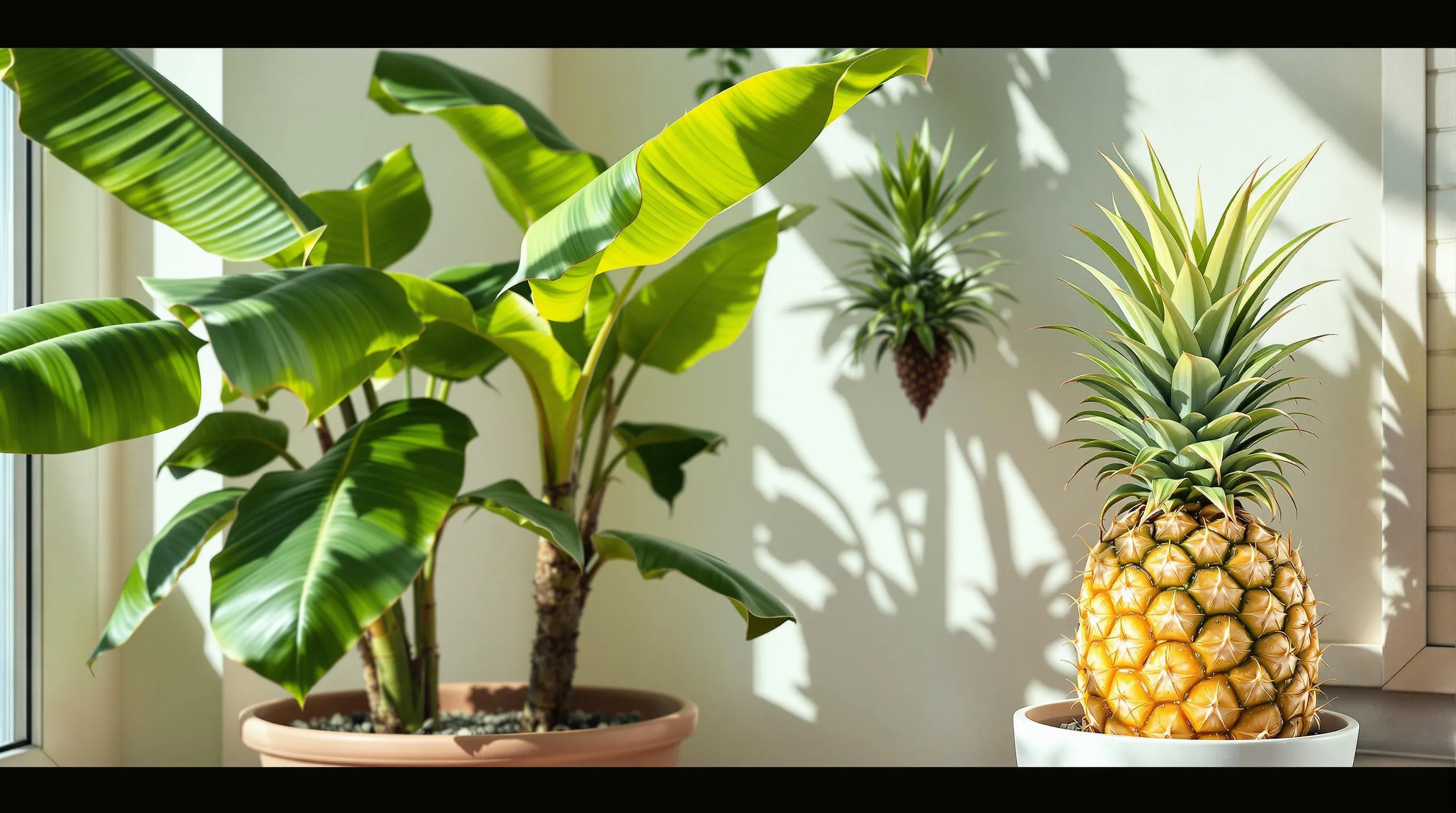
Potted Banana Trees for Bold Statements
Dwarf banana trees make stunning container specimens that bring tropical flair to any indoor space. Varieties like ‘Dwarf Cavendish’ and ‘Super Dwarf Cavendish’ grow just 4-6 feet tall, making them perfect for bright corners of your home. These compact banana plants feature broad, lush foliage that creates an instant tropical statement while remaining manageable in 15-20 gallon containers. While indoor bananas rarely fruit without perfect conditions, some gardeners have successfully harvested small bunches by providing 6+ hours of bright light daily and maintaining consistent humidity levels around 50%. Feed your potted banana monthly with a high-potassium fertilizer during growing season and keep the soil consistently moist but never waterlogged for optimal growth.
Pineapple Plants as Unique Container Specimens
Pineapple plants offer one of the most distinctive and rewarding container gardening experiences for indoor tropical enthusiasts. You can easily start your own by cutting the crown from a store-bought pineapple, allowing it to dry for 2-3 days, then planting it in well-draining potting mix. These plants require minimal space—a 10-12 inch pot is sufficient—and create architectural interest with their spiky, rosette-formed foliage. Indoor pineapples need bright, indirect light and moderate watering (allowing the top inch of soil to dry between waterings). With patience, your potted pineapple can produce a single fruit after 2-3 years, with the added bonus of vibrant reddish-purple flowers emerging from the center of the plant before fruit development begins. Keep temperatures between 65-85°F for optimal growth and mist occasionally to maintain humidity levels that mimic their tropical origins.
Apple and Pear Varieties Suitable for Containers
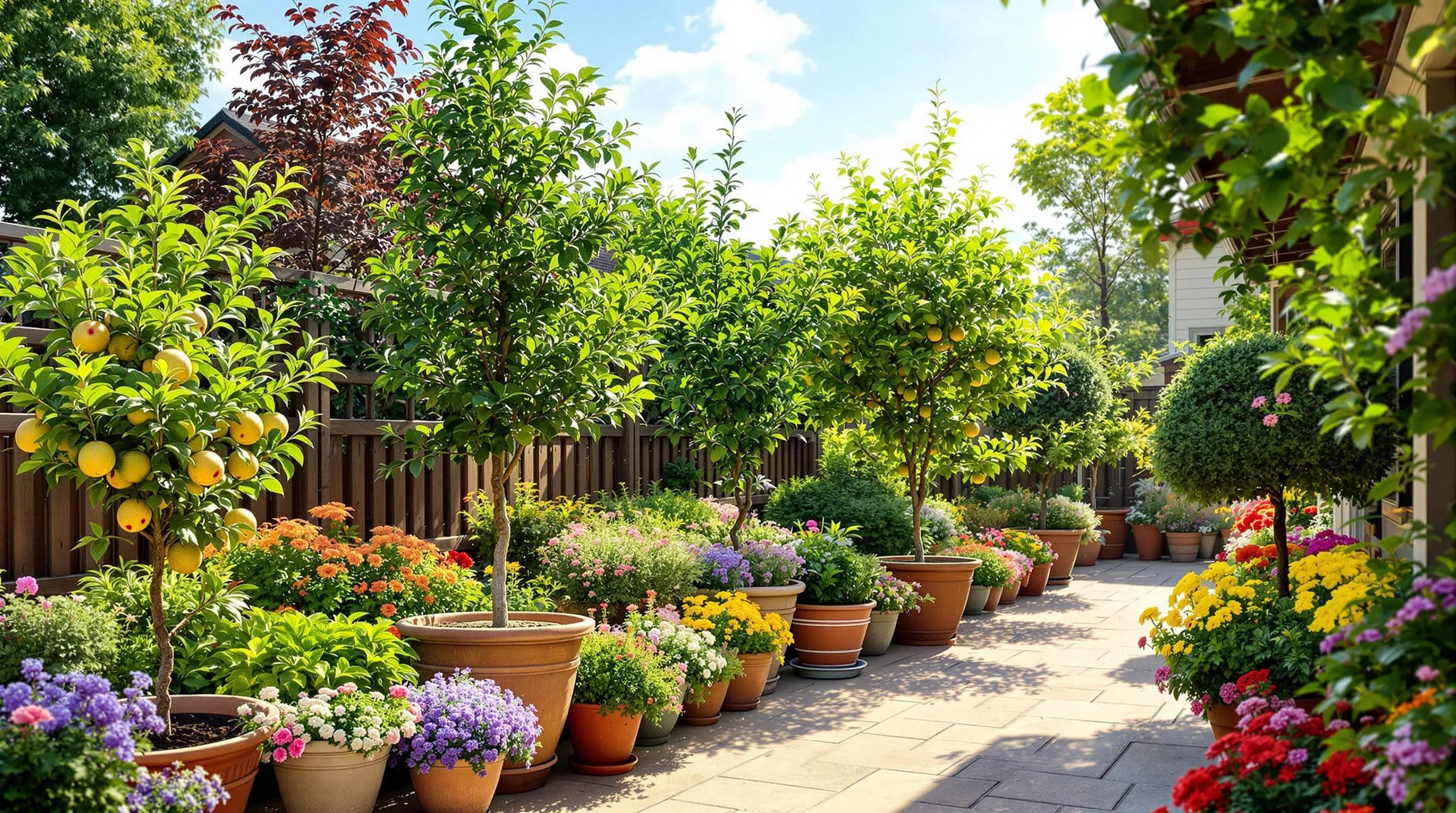
Apple and pear trees have traditionally required large orchards, but thanks to specialized breeding, several compact varieties now thrive in containers. These space-saving fruit trees deliver full-sized, delicious harvests while fitting perfectly on patios, balconies, or small gardens.
Columnar Apples for Narrow Spaces
Columnar apple trees are perfect for container gardening due to their unique vertical growth habit. These slim trees grow upward rather than outward, typically reaching 8-10 feet tall but staying just 2-3 feet wide. ‘North Pole’, ‘Scarlet Sentinel’, and ‘Golden Sentinel’ varieties produce full-sized fruits along their central leader without developing side branches. Plant columnar apples in containers at least 18 inches deep and wide, using well-draining potting soil enriched with compost. Position your potted columnar apple in full sun (6+ hours daily) and water consistently, especially during fruit development. You’ll need to repot every 2-3 years, and most varieties require a pollination partner nearby for optimal fruit production.
Dwarf Pear Cultivars That Produce in Pots
Dwarf pear trees offer impressive yields in surprisingly compact containers. ‘Bartlett’ and ‘D’Anjou’ grafted onto dwarf rootstocks maintain heights of just 8-10 feet while producing sweet, juicy fruits. ‘Patio Pear’ and ‘Garden Pearl’ varieties are specifically bred for container growing, reaching only 4-6 feet tall at maturity. Choose containers 18-24 inches in diameter with excellent drainage, and use high-quality potting mix amended with slow-release fertilizer. Place your potted pear tree where it receives at least 6 hours of direct sunlight daily. Water thoroughly when the top inch of soil feels dry, applying balanced fertilizer in spring and mid-summer. Most dwarf pears are self-pollinating, but planting two different varieties improves fruit set and quality significantly.
Essential Care Tips for Potted Fruit Trees
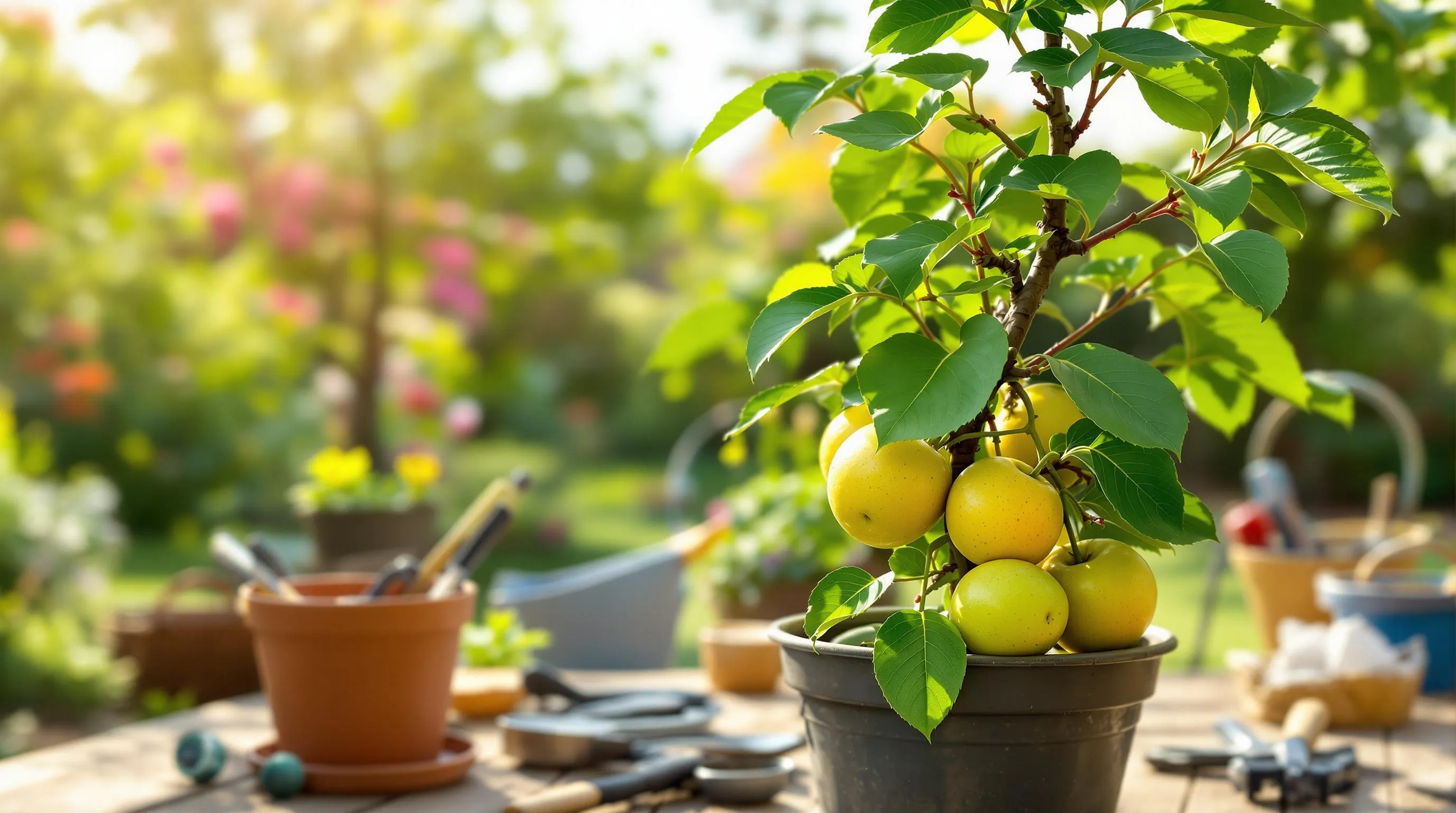
Maintaining healthy potted fruit trees requires consistent care and attention to their unique container-growing needs. Unlike ground-planted trees, container specimens have exact requirements that ensure optimal fruit production and longevity.
Watering and Fertilizing Schedules
Potted fruit trees need more frequent watering than their in-ground counterparts since containers dry out faster. Check moisture levels daily by inserting your finger 1-2 inches into the soil—water thoroughly when it feels dry. During summer months, container trees may need daily watering, while winter may require only weekly attention. Always water until you see drainage flowing from the bottom holes to ensure deep root hydration. For fertilizing, use a slow-release granular fertilizer specifically formulated for fruit trees in spring, followed by monthly liquid fertilizer applications during the growing season (March-August). Reduce fertilizing in fall to prepare trees for dormancy. Citrus trees benefit from additional trace minerals, while stone fruits require less nitrogen to prevent excessive foliage growth at the expense of fruit production.
Pruning Techniques for Container Fruit Trees
Proper pruning maintains the compact size necessary for container-grown fruit trees while maximizing fruit production. Prune during the dormant season (late winter) to remove any dead, damaged, or crossing branches. For most fruit trees, aim to maintain an open center or modified central leader shape to allow sunlight penetration to all branches. Limit the height of your potted trees by pruning the central leader once it reaches your desired height (typically 3-4 feet for dwarf varieties). Thin fruit clusters early in the season, leaving 4-6 inches between developing fruits to improve size and quality. For citrus trees, focus on removing water sprouts and maintaining a rounded shape, while stone fruits benefit from heading cuts to encourage lateral branching. Regular summer tip pruning helps maintain compact growth and redirects energy toward fruit development rather than excessive vegetative growth.
Creative Display Ideas for Multiple Potted Fruit Trees
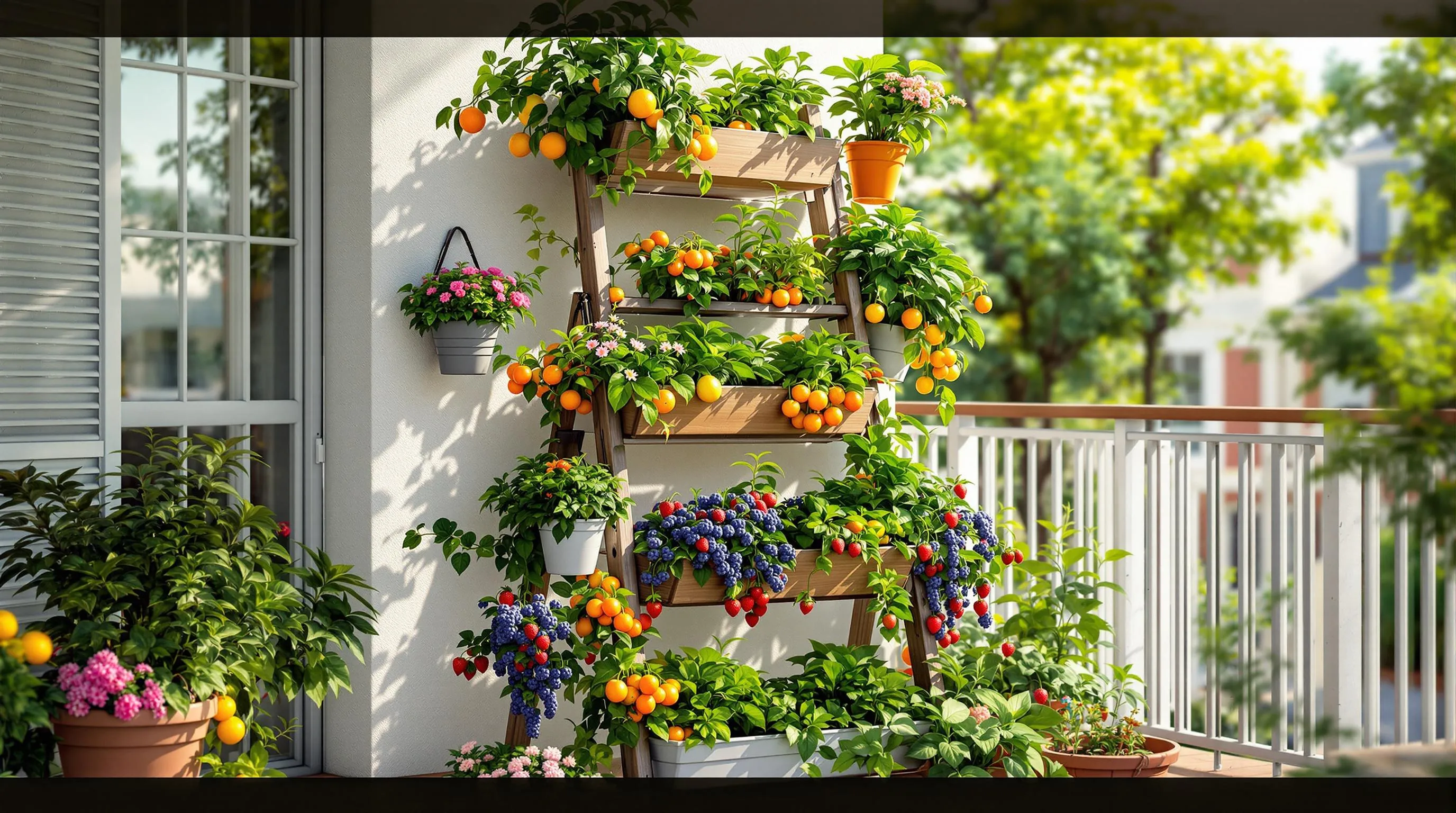
Vertical Gardens and Tiered Arrangements
Transform your limited space into a fruit tree showcase with vertical gardens and tiered arrangements. Use wall-mounted planters or multi-level plant stands to create an eye-catching display that maximizes vertical real estate. A wooden ladder shelf can serve as a perfect tiered stand for smaller citrus trees, with larger containers positioned at the bottom and progressively smaller pots as you move up. For balconies or narrow patios, consider installing a living wall system with integrated planters sized for dwarf fruit varieties like ‘Romeo’ cherries or kumquats. Staggering the heights creates visual interest while ensuring each tree receives adequate sunlight. You’ll effectively double or triple your growing area while creating a stunning focal point that evolves with the seasons.
Mixed Fruit Tree Container Groupings
Create ever-changing container groupings by combining fruit trees with complementary growing requirements and contrasting visual elements. Pair a tall columnar apple tree with compact blueberry bushes and trailing strawberries for a multi-level effect in a corner arrangement. For Mediterranean-inspired groupings, combine fig trees, dwarf pomegranates, and citrus varieties in terracotta containers of varying sizes. Arrange them in odd numbers (3, 5, or 7) for visual appeal, with taller specimens at the back and shorter ones in front. Consider seasonal interest when planning—group early-blooming cherries with later-fruiting apples to extend the visual appeal throughout the growing season. These thoughtful combinations not only maximize your harvesting potential but also create a cohesive design statement that changes throughout the year.
Solving Common Problems with Potted Fruit Trees
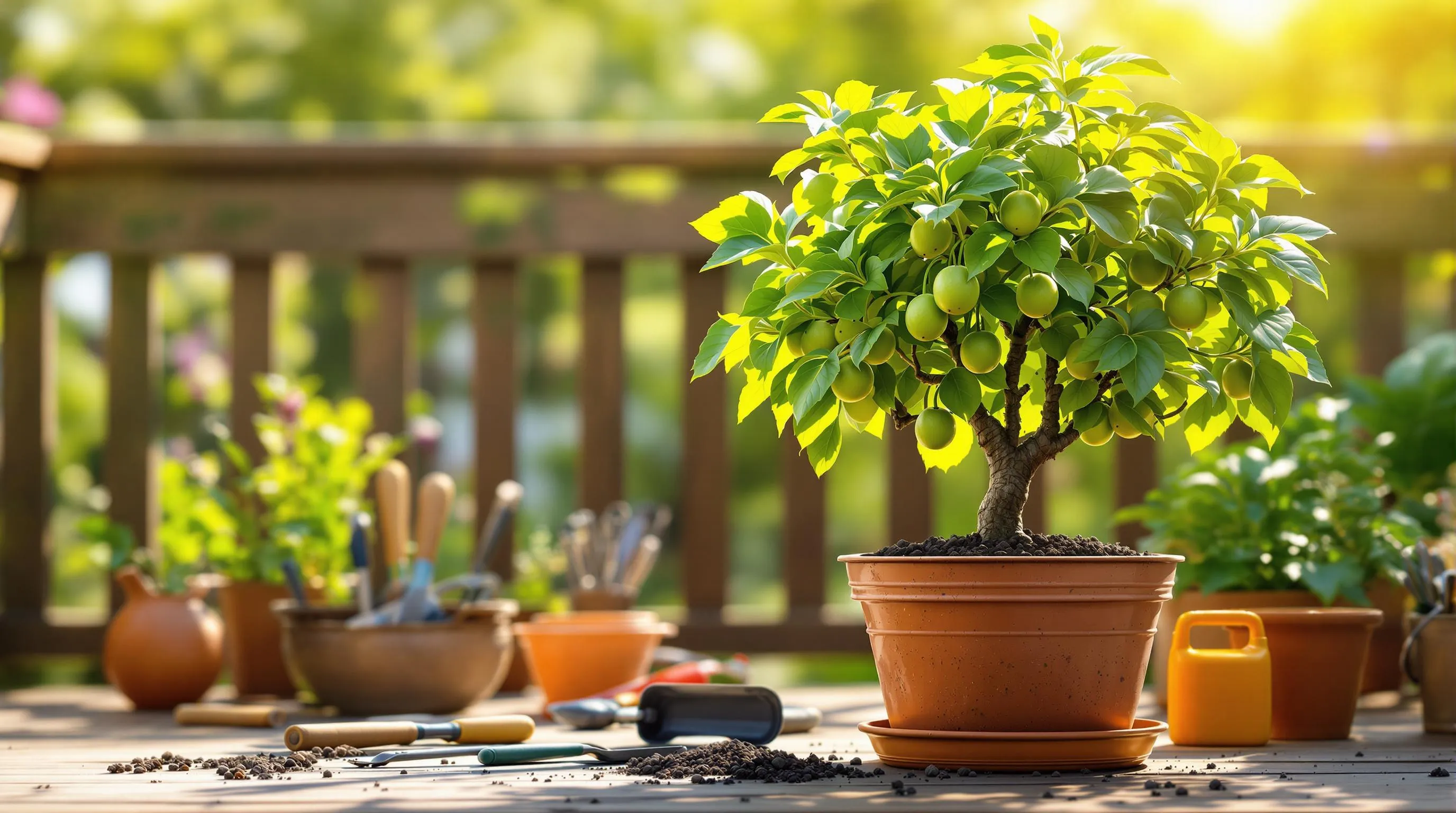
Growing fruit trees in containers comes with unique challenges, but with proper knowledge and care, these issues can be easily overcome. Here are answers to the most common problems you’ll encounter with your potted fruit trees.
Pest Management in Container Environments
Container-grown fruit trees are vulnerable to pests even though being somewhat isolated from ground-dwelling insects. Aphids, spider mites, and scale insects particularly favor potted fruit trees, especially in indoor or sheltered environments. Combat these invaders by inspecting your trees weekly, focusing on leaf undersides and new growth. Introduce beneficial insects like ladybugs for natural pest control, or use insecticidal soap for immediate intervention. Create physical barriers with sticky traps around container rims to catch crawling pests. For severe infestations, neem oil offers an organic solution that disrupts pest life cycles without harming beneficial insects. Unlike ground-planted trees, potted specimens allow you to isolate affected plants quickly, preventing pest spread throughout your collection.
Addressing Nutrient Deficiencies in Potted Trees
Potted fruit trees frequently develop nutrient deficiencies as their limited soil volume becomes depleted faster than ground-planted counterparts. Yellow leaves often signal nitrogen deficiency, while purple-tinged foliage indicates phosphorus shortage. Address these issues with a balanced, slow-release fertilizer specifically formulated for fruit trees. Supplement with liquid seaweed or fish emulsion monthly during the growing season for micronutrients. Perform annual soil refreshment by removing the top 2-3 inches of soil and replacing it with fresh potting mix enriched with compost. Watch for signs of magnesium deficiency (yellowing between leaf veins) common in citrus trees, and correct it with Epsom salt solution (1 tablespoon per gallon of water) applied monthly. Maintain soil pH between 5.5-6.5 for most fruit trees to ensure optimal nutrient availability, testing annually and adjusting with sulfur to lower pH or lime to raise it.
Harvesting Success: Tips for Abundant Fruit Production in Containers
Growing fruit trees in containers opens up a industry of possibilities regardless of your space limitations. With the right selection of dwarf varieties customized to pot life you’ll enjoy both beautiful ornamental plants and delicious homegrown harvests.
Remember that successful container fruit gardening requires attention to pot size drainage and regular care. Your trees will reward your efforts with seasonal blooms vibrant foliage and of course fresh fruits picked straight from your patio balcony or indoor garden.
Whether you choose citrus stone fruits tropical varieties or classic apples and pears your potted orchard can flourish in even the smallest spaces. Start with one or two trees then expand your collection as you gain confidence in your container gardening skills.

